Review of Energy Harvesting for Buildings Based on Solar Energy and Thermal Materials
Abstract
:1. Motivation
2. Methodology
3. Types of Energy Harvesting
4. Uses in Civil Engineering
4.1. Facades
4.2. Roofs
4.3. Structural Materials
4.4. Pavements
5. Advantages and Disadvantages
6. Research Needs
7. Conclusions
- Different methods of harvesting solar energy and thermal materials using Thermoelectric Generator (TEG), solar asphalt collectors, photovoltaic plates, pyroelectric and thermal materials were obtained through numerical simulations and/or experimental tests in climatic conditions as well as bibliographic articles.
- The number of articles on the topic found on the Science Direct database, between 2017 and 2020, was not as expected. This means that in the last four years, little attention has been given to methods of solar capture and thermal energy to use in civil engineering. The piezoelectric method of capturing energy is much more studied, according to the analyzed articles.
- It was also found that there was an increase in the number of articles on the topic of energy harvest, renewable energy and, consequently, also an increase in the number of articles dealing with solar and thermal energy, but still in a small percentage.
- Studies with these methods are of great importance, and research on renewable energies in different parts of the world is increasingly common. However, studies on energy generation from the sun and temperature are rare, which can be considered quite peculiar because the sun and high temperatures exist worldwide. These methods do not emit pollutants and ensure savings for the population if used in engineering projects, for example.
- With the large amounts of pollutant emissions emitted to the environment, it is very important to study alternative renewable energy generation methods, such as piezoelectric, solar, thermal, marine and wind power. However, similar to many authors mentioned in this document, it is extremely beneficial to develop new materials that provide energy for construction, as shown by the great number of thermal materials’ advantages for all energy capture types addressed in this study.
Author Contributions
Funding
Data Availability Statement
Conflicts of Interest
Abbreviations
| ASCs—Solar Asphalt Collectors |
| AC/DC—Current inverter |
| ASHP—Air Source Heat Pump |
| ATO—Antimony-doped tin oxide |
| AlN—Aluminum Nitride |
| Al—Aluminum |
| BDS—Low burst strength |
| BFO or BiFeO3—Bismuth ferrite |
| Bi—Bismuth |
| °C—Degrees Celsius |
| CO2—Carbon dioxide |
| CuO–Copper oxide |
| Cu—Copper |
| CSTS—the theoretical calculation Cu2SrSnS4 |
| CoSe—Cobalt Selenide |
| CoM—Synthesis of transparent and economic ternary alloys |
| DASTT—Dual-axis solar tracking |
| EEG—Electrochemically exfoliated graphene |
| EGCC—Cement with the addition of expanded graphite |
| Fe—Iron |
| FT—Fixed-type photovoltaic |
| GNP—Graphene nanoplatelets |
| HST—Heat storage tank |
| K—Thermal conductivity |
| LED—Light Emitting Diode |
| Ni—Nickel |
| Na—Sodium |
| O—Oxygen |
| PMN-PT—Lead magnesium lead titanate |
| PMN-POM-PZT—lead-antimony magnesium niobate lead-manganese-lead zirconate titanate |
| PS—Saturation polarization |
| Pr—Remaining polarization |
| PVDF—Polyvinylidene Fluoride |
| PV—Different photovoltaic |
| PNB—Cement-based composites with graphene nanoplate |
| PCMs—phase change materials |
| RTEGS—Road thermoelectric generator system |
| Ru—Ruthenium |
| S/cm—Siemens/centimeter |
| SHTE-AP—Thermoelectric energy from asphalt pavement |
| S—Sulfur |
| SASTT—Single-axis solar tracking |
| SiO2—Silicon dioxide |
| SiC—Silicon carbide |
| Ti—Titanium |
| TEG—Thermoelectric Generator |
| TEG-ASG—Thermoelectric generator system in solar asphalt collectors |
References
- Du, H.; Huang, P.; Jones, P. Modular facade retrofit with renewable energy technologies: The definition and current status in Europe. Energy Build. 2019, 205, 109543. [Google Scholar] [CrossRef]
- European Commission. 2030 Climate & Energy Framework. 2014. Available online: https://ec.europa.eu/clima/policies/strategies/2030_en (accessed on 25 July 2021).
- República Portuguesa Plano Nacional Integrado Energia e Clima 2021–2030. 2018. Available online: https://www.portugalenergia.pt/setor-energetico/bloco-3/ (accessed on 25 July 2021).
- Haarstad, H.; Wathne, M.W. Are smart city projects catalyzing urban energy sustainability? Energy Policy 2019, 129, 918–925. [Google Scholar] [CrossRef]
- Dai, Y.; Bai, Y. Performance improvement for building integrated photovoltaics in practice: A review. Energies 2021, 14, 178. [Google Scholar] [CrossRef]
- Gil-Antonio, L.; Saldivar, B.; Portillo-Rodríguez, O.; Ávila-Vilchis, J.C.; Martínez-Rodríguez, P.R.; Martínez-Méndez, R. Flatness-based control for the maximum power point tracking in a photovoltaic system. Energies 2019, 12, 1843. [Google Scholar] [CrossRef] [Green Version]
- Mirzanamadi, R.; Hagentoft, C.E.; Johansson, P. Numerical investigation of harvesting solar energy and anti-icing road surfaces using a hydronic heating pavement and borehole thermal energy storage. Energies 2018, 11, 3443. [Google Scholar] [CrossRef] [Green Version]
- Ahmad, N.; Khandakar, A.; El-Tayeb, A.; Benhmed, K.; Iqbal, A.; Touati, F. Novel design for thermal management of PV cells in harsh environmental conditions. Energies 2018, 11, 3231. [Google Scholar] [CrossRef] [Green Version]
- Zhang, T.; Wang, M.; Yang, H. A review of the energy performance and life-cycle assessment of building-integrated photovoltaic (BIPV) systems. Energies 2018, 11, 3157. [Google Scholar] [CrossRef] [Green Version]
- Shin, D.H.; Choi, S.H. Recent studies of semitransparent solar cells. Coatings 2018, 8, 329. [Google Scholar] [CrossRef] [Green Version]
- Golroodbari, S.Z.M.; De Waal, A.C.; Van Sark, W.G.J.H.M. Improvement of shade resilience in photovoltaic modules using buck converters in a smart module architecture. Energies 2018, 11, 329. [Google Scholar] [CrossRef] [Green Version]
- Velasco, A.; García, S.J.; Guardo, A.; Fontanals, A.; Egusquiza, M. Assessment of the use of venetian blinds as solar thermal collectors in double skin facades in mediterranean climates. Energies 2017, 10, 250. [Google Scholar] [CrossRef] [Green Version]
- Gholikhani, M.; Roshani, H.; Dessouky, S.; Papagiannakis, A.T. A critical review of roadway energy harvesting technologies. Appl. Energy 2020, 261, 114388. [Google Scholar] [CrossRef]
- Wang, H.; Jasim, A.; Chen, X. Energy harvesting technologies in roadway and bridge for different applications—A comprehensive review. Appl. Energy 2018, 212, 1083–1094. [Google Scholar] [CrossRef]
- Shen, M.; Hu, Z.; Qiu, Y.; Qiu, S.; Li, M.Y.; Zhang, G.; Zhang, S.; Yang, Z.; Kagawa, F.; Jiang, S. Thermal energy harvesting performance in 0.94Bi0.5Na0.5TiO3-0.06BaZr0.2Ti0.8O3: AlN composite ceramics based on the Olsen cycle. J. Eur. Ceram. Soc. 2019, 39, 5243–5251. [Google Scholar] [CrossRef]
- Iberdrola What Photovoltaic Energy Is Iberdrola. 2021. Available online: https://www.iberdrola.com/environment/what-is-photovoltaic-energy (accessed on 4 February 2021).
- Duan, J.; Zhao, Y.; He, B.; Tang, Q. Efficiency enhancement of bifacial dye-sensitized solar cells through bi-tandem carbon quantum dots tailored transparent counter electrodes. Electrochim. Acta 2018, 278, 204–209. [Google Scholar] [CrossRef]
- Cai, Y.; Guo, Z. Spectral investigation of solar energy absorption and light transmittance in a water-filled prismatic glass louver. Sol. Energy 2019, 179, 164–173. [Google Scholar] [CrossRef]
- Wang, C.; Yu, S.; Guo, X.; Kearney, T.; Guo, P.; Chang, R.; Chen, J.; Chen, W.; Sun, C. Maximizing Solar Energy Utilization through Multicriteria Pareto Optimization of Energy Harvesting and Regulating Smart Windows. Cell Rep. Phys. Sci. 2020, 1, 100108. [Google Scholar] [CrossRef]
- Liu, T.; Zhao, Y.; Duan, J.; He, B.; Zheng, J.; Tang, Q. Transparent ternary alloy counter electrodes for high-efficiency bifacial dye-sensitized solar cells. Sol. Energy 2018, 170, 762–768. [Google Scholar] [CrossRef]
- Alva, M.; Vlachokostas, A.; Madamopoulos, N. Experimental demonstration and performance evaluation of a complex fenestration system for daylighting and thermal harvesting. Sol. Energy 2020, 197, 385–395. [Google Scholar] [CrossRef]
- Lin, Q.; Zhang, Y.; Van Mieghem, A.; Chen, Y.C.; Yu, N.; Yang, Y.; Yin, H. Design and experiment of a sun-powered smart building envelope with automatic control. Energy Build. 2020, 223, 110173. [Google Scholar] [CrossRef]
- Sheikh, W.T.; Asghar, Q. Adaptive biomimetic facades: Enhancing energy efficiency of highly glazed buildings. Front. Archit. Res. 2019, 8, 319–331. [Google Scholar] [CrossRef]
- Talaei, M.; Mahdavinejad, M.; Azari, R. Thermal and Energy Performance of Algae Bioreactive Façades: A Review. J. Build. Eng. 2019, 28, 101011. [Google Scholar] [CrossRef]
- Romero, V.S.; Arquitecturayempresa. Fachada Biosensible. 2015. Available online: https://www.arquitecturayempresa.es/noticia/fachada-biosensible (accessed on 4 December 2019).
- Bartolacci, J.; Architizer. Why Building Facades Are the Future of Clean Energy Farms. 2019. Available online: https://architizer.com/blog/inspiration/stories/energy-harvesting-facades/ (accessed on 4 December 2019).
- Voltimum Edifício Solar XXI—Edifício Energeticamente Eficiente. Available online: https://www.voltimum.pt/artigos/noticias-do-sector/edificio-solar-xxi (accessed on 5 December 2019).
- Construible Investigadores Alemanes Diseñan Fachadas Solares Que Aportan Un 50% Más De Energía Que Otros Sistemas. Available online: https://www.construible.es/2020/03/17/investigadores-alemanes-disenan-fachadas-solares-aportan-50-energia-edificio#.XnDC553epPI.email (accessed on 22 April 2020).
- Wang, Q.; Bowen, C.R.; Lewis, R.; Chen, J.; Lei, W.; Zhang, H.; Li, M.Y.; Jiang, S. Hexagonal boron nitride nanosheets doped pyroelectric ceramic composite for high-performance thermal energy harvesting. Nano Energy 2019, 60, 144–152. [Google Scholar] [CrossRef]
- Bellas, D.V.; Lidorikis, E. Design of high-temperature solar-selective coatings for application in solar collectors. Sol. Energy Mater. Sol. Cells 2017, 170, 102–113. [Google Scholar] [CrossRef]
- Bohara, B.B.; Batra, A.K. Development of multi-functional nano-paint for energy harvesting applications. Prog. Nat. Sci. Mater. Int. 2018, 28, 1–6. [Google Scholar] [CrossRef]
- Silva-Leon, J.; Cioncolini, A.; Nabawy, M.R.A.; Revell, A.; Kennaugh, A. Simultaneous wind and solar energy harvesting with inverted flags. Appl. Energy 2019, 239, 846–858. [Google Scholar] [CrossRef] [Green Version]
- Jia, H.; Cheng, X.; Zhu, J.; Li, Z.; Guo, J. Mathematical and experimental analysis on solar thermal energy harvesting performance of the textile-based solar thermal energy collector. Renew. Energy 2018, 129, 553–560. [Google Scholar] [CrossRef]
- Gagliano, A.; Aneli, S.; Nocera, F. Analysis of the performance of a building solar thermal facade (BSTF) for domestic hot water production. Renew. Energy 2019, 142, 511–526. [Google Scholar] [CrossRef]
- Velho, M. Empresa Portuguesa Quer Pôr Painéis Solares Térmicos Nas Fachadas de Edifícios. Available online: https://www.dinheirovivo.pt/fazedores/empresa-portuguesa-quer-por-paineis-solares-termicos-nas-fachadas-de-edificios/ (accessed on 5 December 2019).
- Atsolar O Primeiro Painel Solar Térmico Que Faz Tudo. Available online: https://atsolar.pt/pt/senergy-force-pt/ (accessed on 5 December 2019).
- Rounis, E.D.; Athienitis, A.; Stathopoulos, T. Review of air-based PV/T and BIPV/T systems-Performance and modelling. Renew. Energy 2021, 163, 1729–1753. [Google Scholar] [CrossRef]
- Nagy, Z.; Svetozarevic, B.; Jayathissa, P.; Begle, M.; Hofer, J.; Lydon, G.; Willmann, A.; Schlueter, A. The Adaptive Solar Facade: From concept to prototypes. Front. Archit. Res. 2016, 5, 143–156. [Google Scholar] [CrossRef] [Green Version]
- Freitas, S.; Brito, M.C. Solar façades for future cities. Renew. Energy Focus 2019, 31, 73–79. [Google Scholar] [CrossRef]
- Matuska, T. Simulation study of building integrated solar liquid PV-T collectors. Int. J. Photoenergy 2012, 2012. [Google Scholar] [CrossRef]
- Zhang, J.; Xu, L.; Shabunko, V.; Tay, S.E.R.; Sun, H.; Lau, S.S.Y.; Reindl, T. Impact of urban block typology on building solar potential and energy use efficiency in tropical high-density city. Appl. Energy 2019, 240, 513–533. [Google Scholar] [CrossRef]
- Xiao, H.; Chen, Z.; Sun, K.; Yan, C.; Xiao, J.; Jiang, L.; Hao, X. Sol-gel solution-processed Cu 2 SrSnS 4 thin films for solar energy harvesting. Thin Solid Film. 2020, 697, 137828. [Google Scholar] [CrossRef]
- Kuo, K.; Liao, M.; Wang, J.; Lee, Y.; Huang, C.; Chou, C.; Liu, C.; Hsu, H.; Chen, P. Comprehensive assessment of the long-term energy harvest capabilities for PV systems with di ff erent tilt angles: Case study in Taiwan. Renew. Sustain. Energy Rev. 2018, 97, 74–89. [Google Scholar] [CrossRef]
- Lamichhane, S.; Sharma, S.; Tomar, M.; Gupta, V. Effect of laser fluence on multiferroic BiFeO3 ferroelectric photovoltaic cells. J. Phys. Chem. Solids 2020, 146, 109602. [Google Scholar] [CrossRef]
- Pereira, R.I.S.; Camboim, M.M.; Villarim, A.W.R.; Souza, C.P.; Jucá, S.C.S.; Carvalho, P.C.M. On harvesting residual thermal energy from photovoltaic module back surface. AEU Int. J. Electron. Commun. 2019, 111, 152878. [Google Scholar] [CrossRef]
- Fathabadi, H. Solar energy harvesting in buildings using a proposed novel electrochemical device as an alternative to PV modules. Renew. Energy 2019, 133, 118–125. [Google Scholar] [CrossRef]
- Sharma, H.; Haque, A.; Jaffery, Z.A. Maximization of wireless sensor network lifetime using solar energy harvesting for smart agriculture monitoring. Ad Hoc Netw. 2019, 94, 101966. [Google Scholar] [CrossRef]
- Cai, Y.; Wang, L.; Wang, W.W.; Liu, D.; Zhao, F.Y. Solar energy harvesting potential of a photovoltaic-thermoelectric cooling and power generation system: Bidirectional modeling and performance optimization. J. Clean. Prod. 2020, 254, 120150. [Google Scholar] [CrossRef]
- Jafari Mosleh, H.; Ahmadi, R. Linear parabolic trough solar power plant assisted with latent thermal energy storage system: A dynamic simulation. Appl. Therm. Eng. 2019, 161, 114204. [Google Scholar] [CrossRef]
- Jeyashree, Y.; Sukhi, Y.; Vimala Juliet, A.; Lourdu Jame, S.; Indirani, S. Concentrated solar thermal energy harvesting using Bi2Te3based thermoelectric generator. Mater. Sci. Semicond. Process. 2020, 107, 104782. [Google Scholar] [CrossRef]
- Byon, Y.S.; Jeong, J.W. Phase change material-integrated thermoelectric energy harvesting block as an independent power source for sensors in buildings. Renew. Sustain. Energy Rev. 2020, 128, 109921. [Google Scholar] [CrossRef]
- Ghosh, S.; Harish, S.; Ohtaki, M.; Saha, B.B. Enhanced figure of merit of cement composites with graphene and ZnO nanoinclusions for efficient energy harvesting in buildings. Energy 2020, 198, 117396. [Google Scholar] [CrossRef]
- Ghosh, S.; Harish, S.; Rocky, K.A.; Ohtaki, M.; Saha, B.B. Graphene enhanced thermoelectric properties of cement based composites for building energy harvesting. Energy Build. 2019, 202, 109419. [Google Scholar] [CrossRef]
- Wei, J.; Zhao, L.; Zhang, Q.; Nie, Z.; Hao, L. Enhanced thermoelectric properties of cement-based composites with expanded graphite for climate adaptation and large-scale energy harvesting. Energy Build. 2018, 159, 66–74. [Google Scholar] [CrossRef]
- Krystek, M.; Pakulski, D.; Patroniak, V.; Górski, M.; Szojda, L.; Ciesielski, A.; Samorì, P. High-Performance Graphene-Based Cementitious Composites. Adv. Sci. 2019, 6, 1801195. [Google Scholar] [CrossRef] [Green Version]
- O’Hegarty, R.; Kinnane, O.; McCormack, S.J. Parametric investigation of concrete solar collectors for façade integration. Sol. Energy 2017, 153, 396–413. [Google Scholar] [CrossRef]
- Liao, X.; Liu, Y.; Ren, J.; Guan, L.; Sang, X. Investigation of a double-PCM-based thermoelectric energy- harvesting device using temperature fl uctuations in an ambient environment. Energy 2020, 202, 117724. [Google Scholar] [CrossRef]
- Chen, N.; Ma, H.; Li, Y.; Cheng, J.; Zhang, C.; Wu, D.; Zhu, H. Complementary optical absorption and enhanced solar thermal conversion of CuO-ATO nanofluids. Sol. Energy Mater. Sol. Cells 2017, 162, 83–92. [Google Scholar] [CrossRef]
- Bhalla, V.; Tyagi, H. Solar energy harvesting by cobalt oxide nanoparticles, a nanofluid absorption based system. Sustain. Energy Technol. Assess. 2017, 24, 45–54. [Google Scholar] [CrossRef]
- Wu, S.; Xiong, G.; Yang, H.; Tian, Y.; Gong, B.; Wan, H.; Wang, Y.; Fisher, T.S.; Yan, J.; Cen, K.; et al. Scalable Production of Integrated Graphene Nanoarchitectures for Ultrafast Solar-Thermal Conversion and Vapor Generation. Matter 2019, 1, 1017–1032. [Google Scholar] [CrossRef] [Green Version]
- Li, X.; Zhang, J.; Fu, B.; Song, C.; Shang, W.; Tao, P.; Deng, T. Erythritol impregnated within surface-roughened hydrophilic metal foam for medium-temperature solar-thermal energy harvesting. Energy Convers. Manag. 2020, 222, 113241. [Google Scholar] [CrossRef]
- Norambuena-Contreras, J.; Concha, J.L.; Borinaga-Treviño, R. Evaluation of the thermophysical and heating properties of a composite rubber membrane with energy harvesting purposes. Polym. Test. 2017, 64, 145–155. [Google Scholar] [CrossRef]
- Jiang, W.; Yuan, D.; Xu, S.; Hu, H.; Xiao, J.; Sha, A.; Huang, Y. Energy harvesting from asphalt pavement using thermoelectric technology. Appl. Energy 2017, 205, 941–950. [Google Scholar] [CrossRef]
- Zabihi, N.; Saafi, M. Recent developments in the energy harvesting systems from road infrastructures. Sustainability 2020, 12, 6738. [Google Scholar] [CrossRef]
- Tahami, S.A.; Gholikhani, M.; Nasouri, R.; Dessouky, S.; Papagiannakis, A.T. Developing a new thermoelectric approach for energy harvesting from asphalt pavements. Appl. Energy 2019, 238, 786–795. [Google Scholar] [CrossRef]
- Zhu, X.; Yu, Y.; Li, F. A review on thermoelectric energy harvesting from asphalt pavement: Configuration, performance and future. Constr. Build. Mater. 2019, 228, 116818. [Google Scholar] [CrossRef]
- Wang, Y.; Rao, Z.; Liu, J.; Liao, S. An optimized control strategy for integrated solar and air-source heat pump water heating system with cascade storage tanks. Energy Build. 2020, 210, 109766. [Google Scholar] [CrossRef]
- Hasebe, M.; Kamikawa, Y.; Meiarashi, S. Thermoelectric generators using solar thermal energy in heated road pavement. In Proceedings of the IEEE 2006 25th International Conference on Thermoelectrics, Vienna, Austria, 6–10 August 2006. [Google Scholar]
- Zhou, Y.; Zhang, S.; Xu, X.; Liu, W.; Zhang, S.; Li, G.; He, J. Dynamic piezo-thermoelectric generator for simultaneously harvesting mechanical and thermal energies. Nano Energy 2020, 69, 104397. [Google Scholar] [CrossRef]
- Kwan, T.H.; Wu, X.; Yao, Q. Complete implementation of the combined TEG-TEC temperature control and energy harvesting system. Control. Eng. Pract. 2020, 95, 104224. [Google Scholar] [CrossRef]
- Chiarelli, A.; Al-Mohammedawi, A.; Dawson, A.R.; García, A. Construction and configuration of convection-powered asphalt solar collectors for the reduction of urban temperatures. Int. J. Therm. Sci. 2017, 112, 242. [Google Scholar] [CrossRef]
- Bobes-Jesus, V.; Pascual-Muñoz, P.; Castro-Fresno, D.; Rodriguez-Hernandez, J. Asphalt solar collectors: A literature review. Appl. Energy 2013, 102, 962–970. [Google Scholar] [CrossRef]
- Verma, S.K.; Gupta, N.K.; Rakshit, D. A comprehensive analysis on advances in application of solar collectors considering design, process and working fluid parameters for solar to thermal conversion. Sol. Energy 2020, 208, 1114–1150. [Google Scholar] [CrossRef]
- Johnsson, J.; Adl-Zarrabi, B. A numerical and experimental study of a pavement solar collector for the northern hemisphere. Appl. Energy 2020, 260, 114286. [Google Scholar] [CrossRef]
- Mallick, R.B.; Chen, B.L.; Bhowmick, S. Harvesting energy from asphalt pavements and reducing the heat island effect. Int. J. Sustain. Eng. 2009, 2, 214–228. [Google Scholar] [CrossRef]
- Apren Production. 2021. Available online: https://www.apren.pt/en/renewable-energies/production/ (accessed on 25 July 2021).
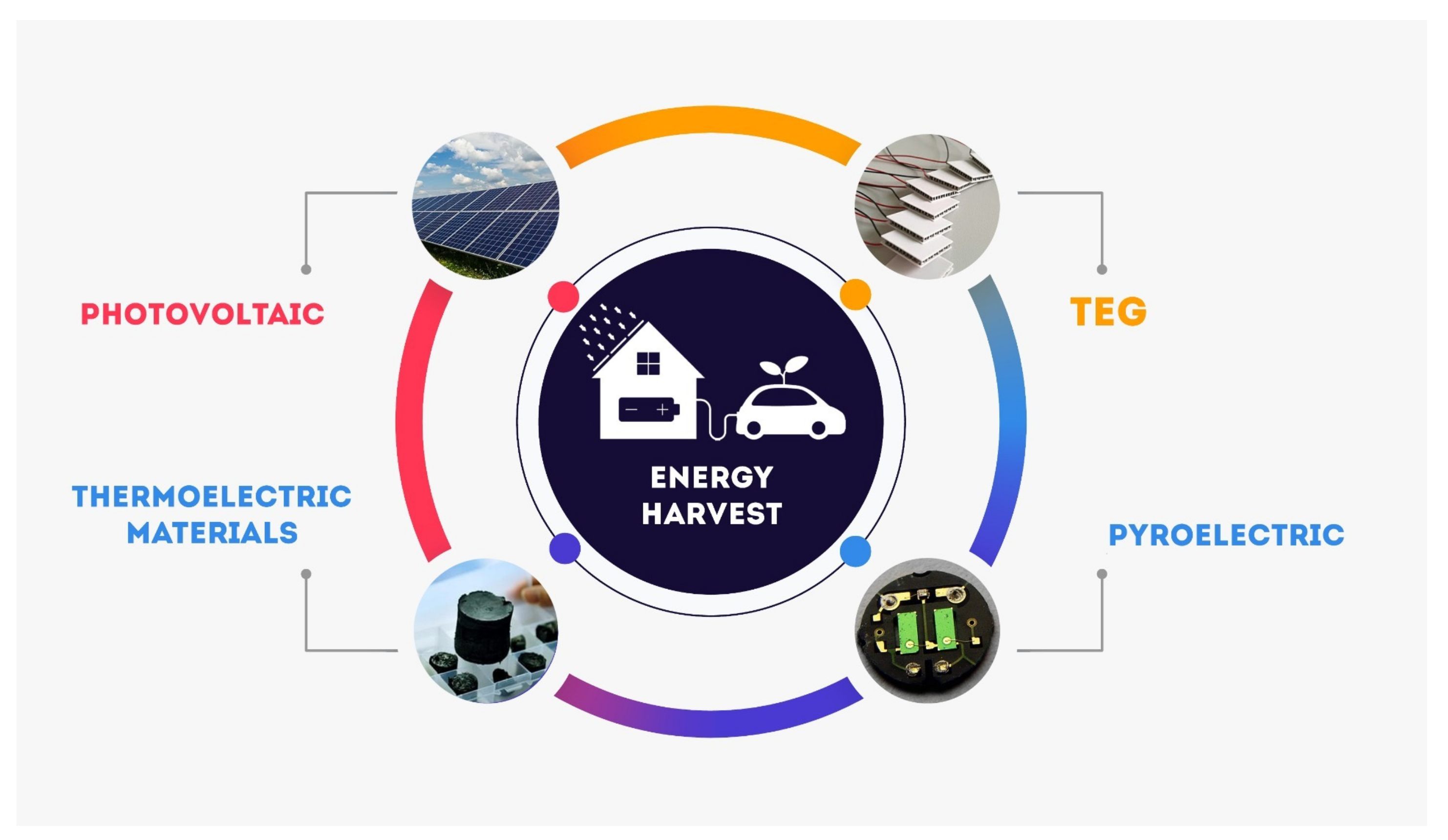
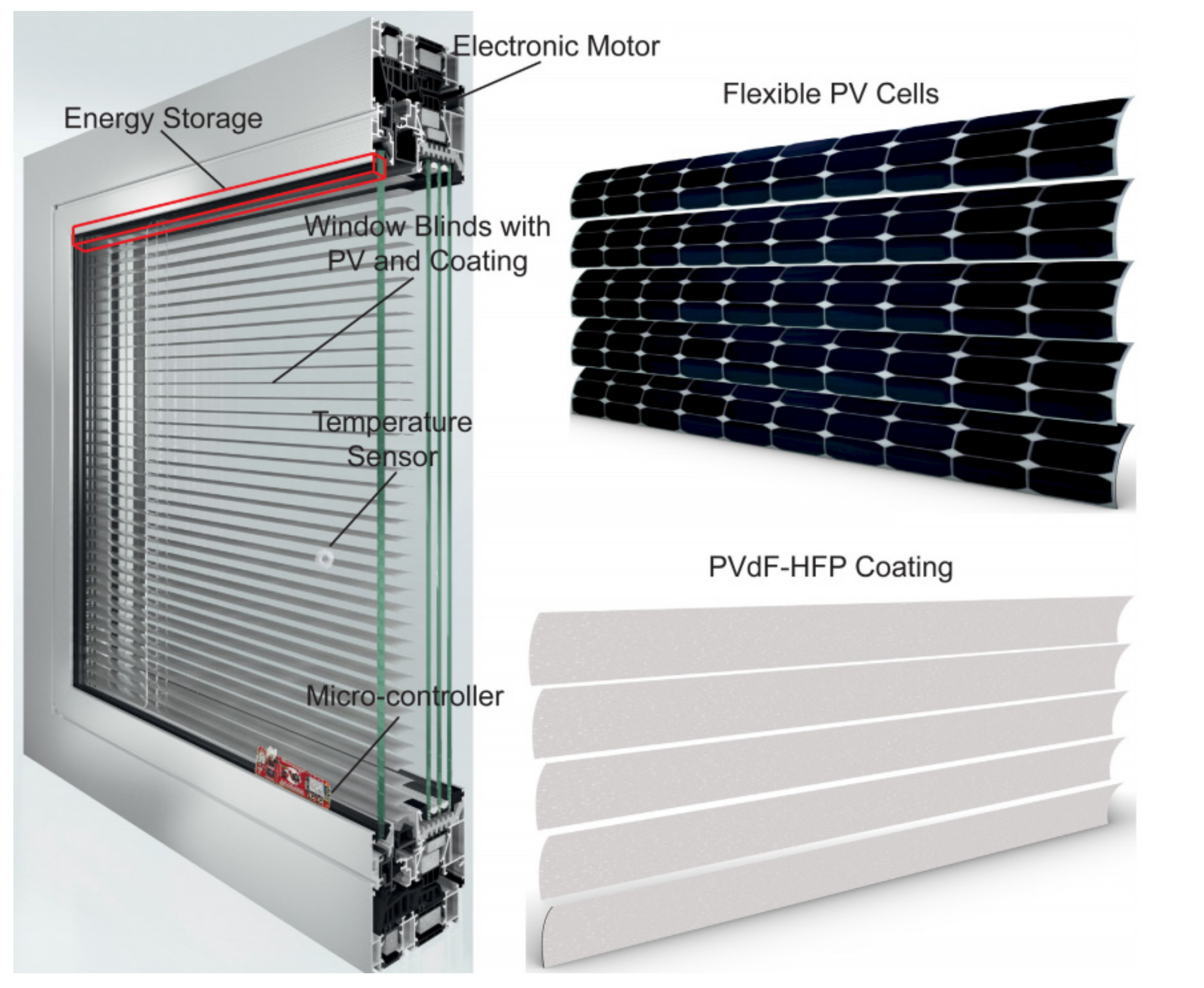
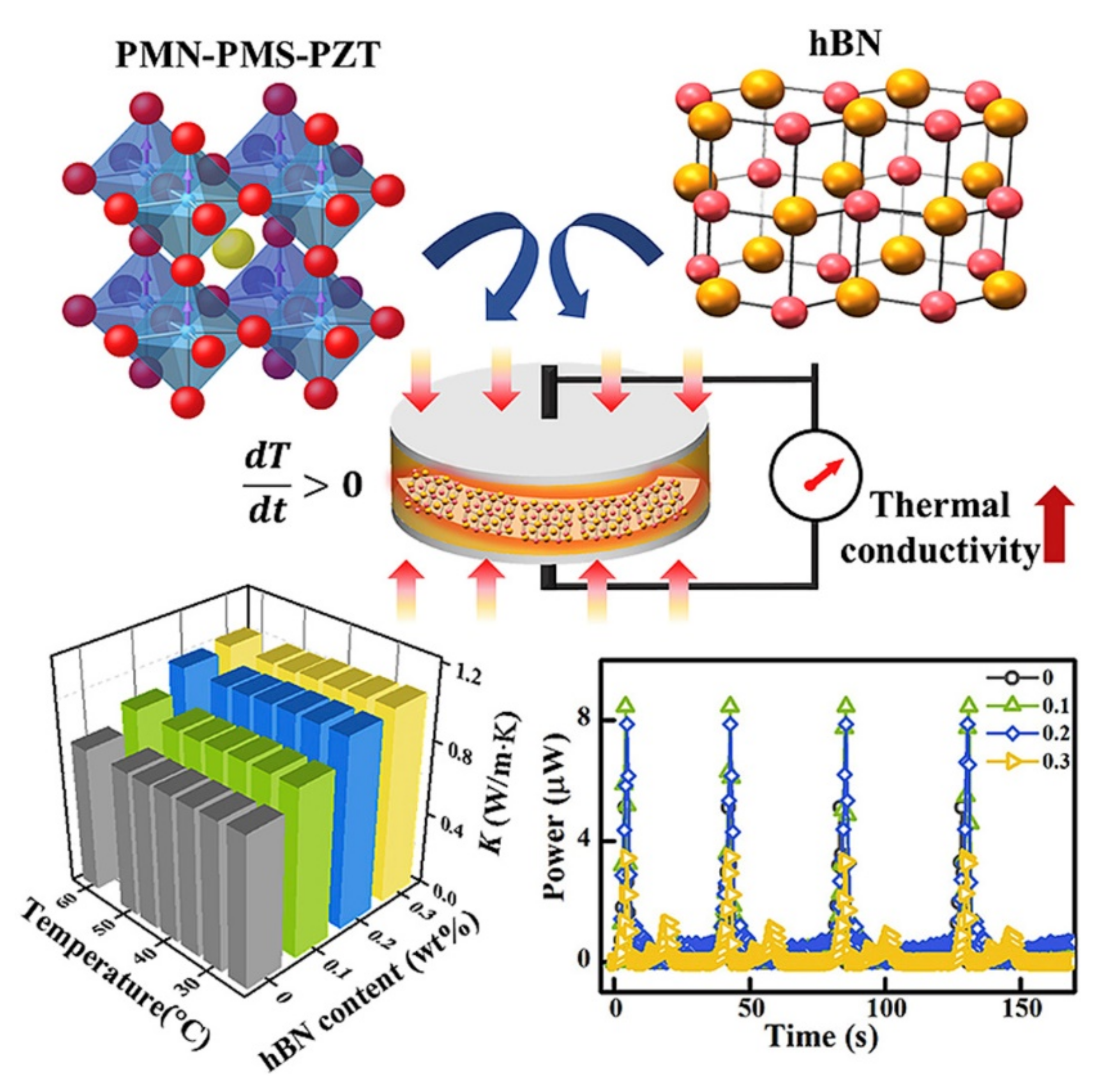
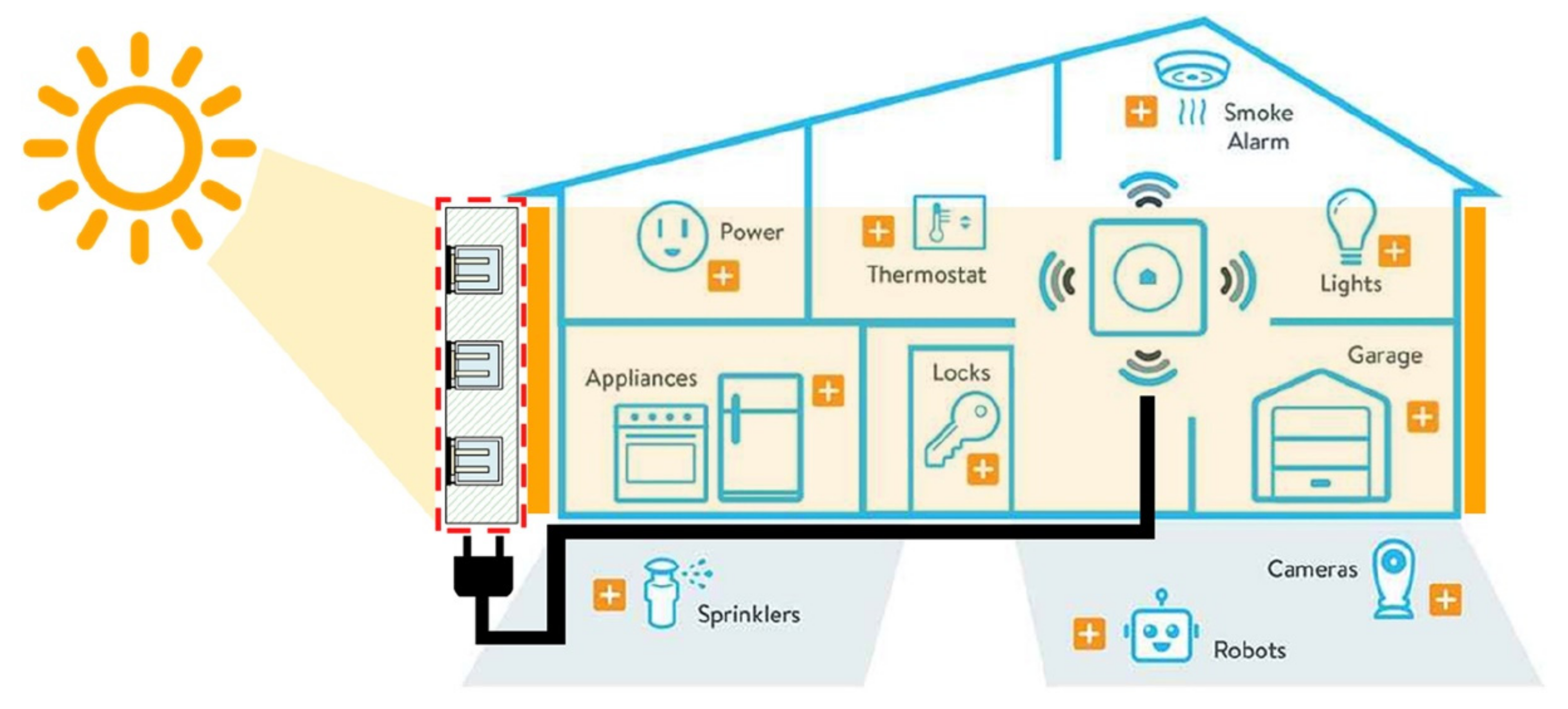
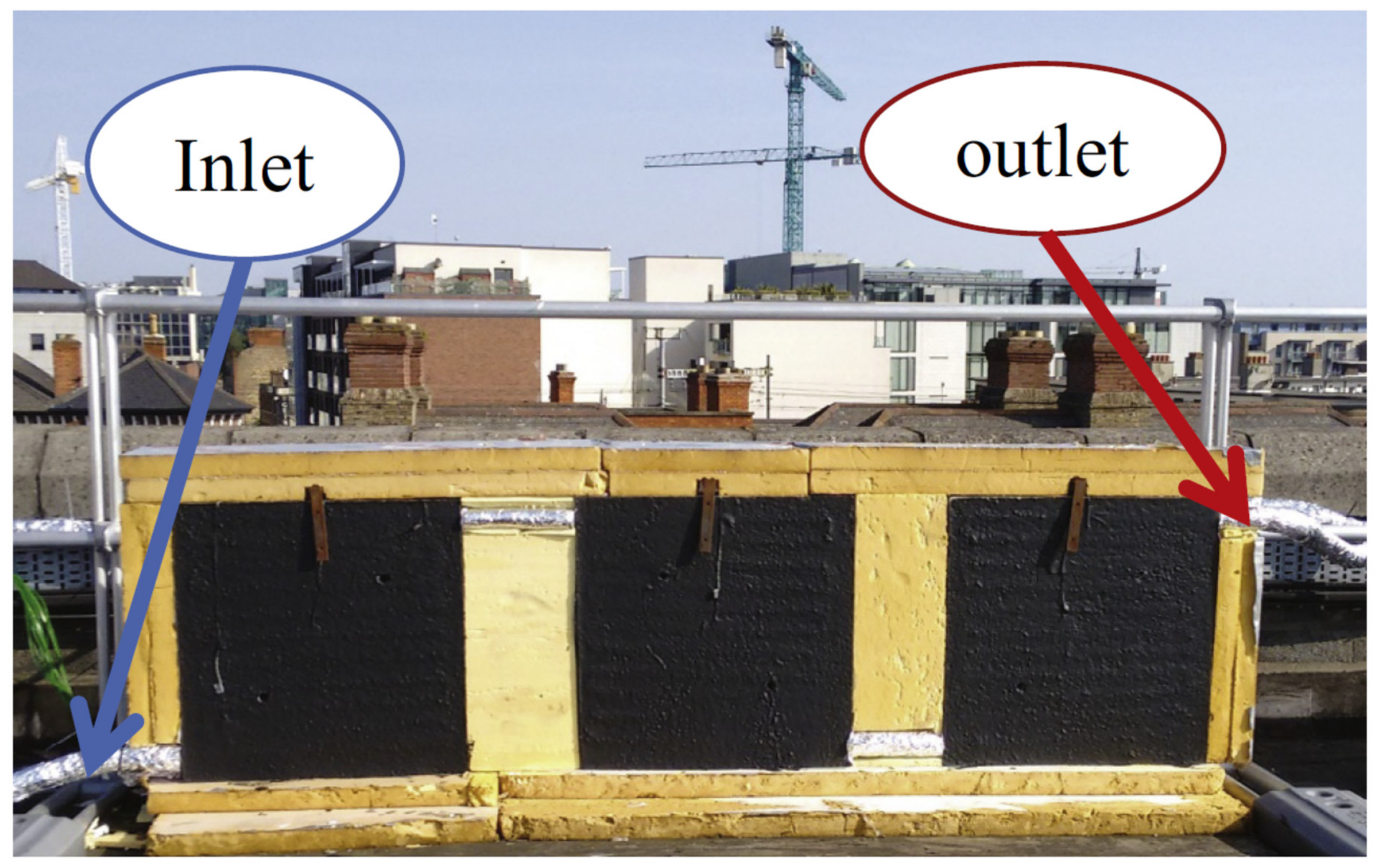
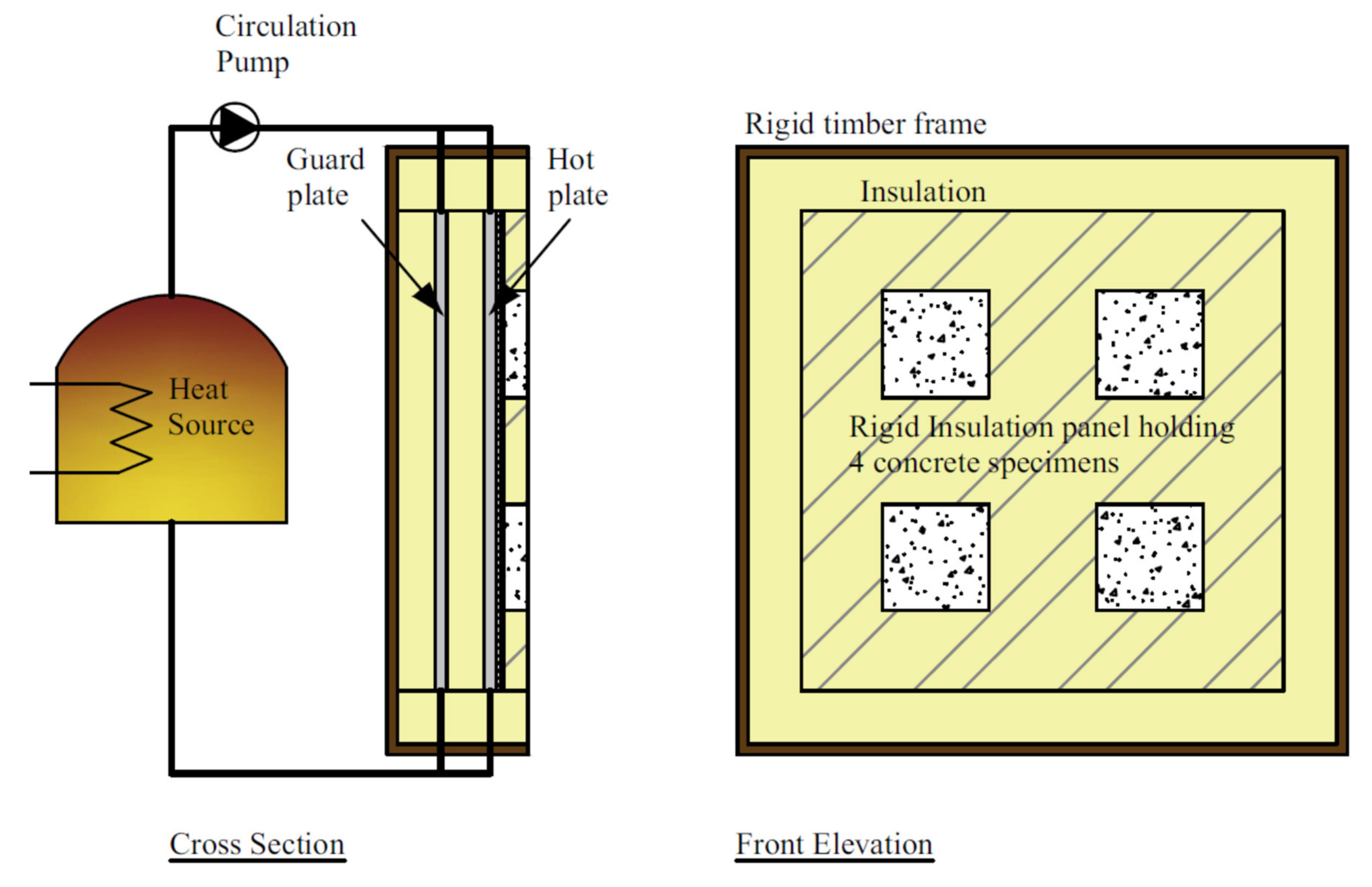



| FACADES | |
|---|---|
| ADVANTAGES | Photovoltaic: Use of photovoltaic cells in windows and blinds to obtain greater natural light and solar energy [26,27,28,29,30,31]. Thermal materials: Use of window glass to heat a water pipe to provide solar energy and greater natural lighting [27]. Use of fabrics that can be used in lighting locations to generate energy [13,31]. Use of anchor paints with components that increase thermal conductivity [30]. Pyroelectricity: Use of a new ceramic with components that increase the redemption of solar energy generation. In addition to increasing the breaking strength of the ceramic [27,28,29]. |
| DISADVANTAGES | Photovoltaic: Limited architecture and aesthetics [21,22,23,24,25,26]. Visual pollution [21,22,23,24,25,26]. Thermal materials: Limited architecture and aesthetics [13,22,30,31]. Pyroelectricity: Limited architecture and aesthetics [27,28,29]. |
| ROOFS | |
|---|---|
| ADVANTAGES | Photovoltaic: The use decreases the internal temperature of the building [32]. The CSTS component in the photovoltaic cell increases energy generation [33]. The SASTT system showed better power generation than the FT [34]. Ferroelectric materials increased the energy generation of photovoltaic cells [35]. Thermal materials: The increase in energy generation using NaNO3 material as a phase change in a roof gutter [40]. TEGs: Consequently, the temperature difference and energy generation increase through the photovoltaic plates’ surface and the shaded part [36,37]. The high-temperature difference between the roof and the shaded part [36,37]. |
| DISADVANTAGES | Photovoltaic: Visual pollution [32,33,34] Thermal materials: It was not observed TEGs: It was not observed |
| IN STRUCTURAL MATERIALS | |
|---|---|
| ADVANTAGES | Thermal materials: Adding graphene and EGCC to cement increases thermal conductivity [43,44]. It improves the internal comfort of the building [43,44]. It presents better microstructure and mechanical properties and presents high workability concerning cement without EEG [45]. The solar concrete collector achieves a good performance in energy generation and durability. In addition to obtaining water with a different temperature to be used in the building [46]. The use of 2 types of phase-changing material makes the generation of energy more uniform with a large temperature difference [44,45] The addition of 0.5% of steel fibers increases energy generation [62]. TEGs: Get energy with materials with phase change in bricks. Fresnel lenses concentrate the sun’s rays on materials based on bismuth telluride [41] |
| DISADVANTAGES | Thermal materials: If excess graphene is added, the porosity increases and the compressive strength decreases [44]. TEGs: It was not observed. |
| PAVING | |
|---|---|
| ADVANTAGES | Photovoltaic: large extension and protection against noise [17] Thermal materials and TEGS: The floor material has high thermal conductivity [48,54]. Dark color [31,57,58,62]. High conductivity for water in the pipe [75]. PEX-AL tubing performs better [17,42,58,59,60,61,62,63]. |
| DISADVANTAGES | Photovoltaic: Low durability due to high traffic loads [18]. Thermal materials: Iron pipe showed corrosion and leakage [17,42,59,60,61,62,63]. TEGs: It was not observed. |
Publisher’s Note: MDPI stays neutral with regard to jurisdictional claims in published maps and institutional affiliations. |
© 2021 by the authors. Licensee MDPI, Basel, Switzerland. This article is an open access article distributed under the terms and conditions of the Creative Commons Attribution (CC BY) license (https://creativecommons.org/licenses/by/4.0/).
Share and Cite
Sucupira, L.; Castro-Gomes, J. Review of Energy Harvesting for Buildings Based on Solar Energy and Thermal Materials. CivilEng 2021, 2, 852-873. https://doi.org/10.3390/civileng2040046
Sucupira L, Castro-Gomes J. Review of Energy Harvesting for Buildings Based on Solar Energy and Thermal Materials. CivilEng. 2021; 2(4):852-873. https://doi.org/10.3390/civileng2040046
Chicago/Turabian StyleSucupira, Luciana, and João Castro-Gomes. 2021. "Review of Energy Harvesting for Buildings Based on Solar Energy and Thermal Materials" CivilEng 2, no. 4: 852-873. https://doi.org/10.3390/civileng2040046
APA StyleSucupira, L., & Castro-Gomes, J. (2021). Review of Energy Harvesting for Buildings Based on Solar Energy and Thermal Materials. CivilEng, 2(4), 852-873. https://doi.org/10.3390/civileng2040046







